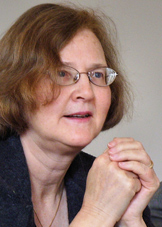A Nobel links aging, cancer, evolution and politics


Oh, and there's a dose of politics.
Elizabeth Blackburn and Jack Szostak were colleagues in the early 1980s, and Carol Greider was a Blackburn grad student, when Greider discovered the enzyme telemorase in 1984. Greider thus becomes famous for winning a science Nobel at the relatively "young" age of 48.
Szostak has since worked on the evolutionary aspects of this discovery, seeking explanations for how chemistry became biology in Earth's earliest days.
Blackburn and Greidner worked on how telemorase builds telomeres at the end of DNA, redundant genes that protect the underlying DNA structure like a plastic cap on a twisted electrical connection. Telemorase declines as we age, but becomes abundant in cancer.
The practical result might be a cancer vaccine which attacks cells that produce telemorase, turning off the cancer process while allowing normal aging to continue.
We promised some politics, and it comes from Blackburn (above, from the Nobel Prize Web site).
Appointed to the President's Council on Bioethics in 2001, she was fired in 2004, but she did not go quietly. Instead she blew the whistle on the Administration's "political distortion" of biomedical science, detailing it all with another member, Janet Rowley, at PLoS Biology.
Oh, and before my fellow Americans haul out their USA chants, Blackburn was born in Australia and Szostak in England.